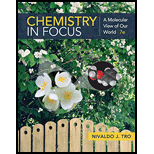
Concept explainers
Interpretation:
The protons, neutrons, and electrons for each of the given element are to be determined.
Concept Introduction:
An atom consists of a nucleus and extranuclear space.
Atoms of an element can exist in more than one form. Each form is termed as an isotope and only the number of neutrons is different in each form while the number of protons and electrons is the same.
When an atom loses or gains an electron, it is termed as cation or anion, respectively. Cation bears a positive charge and contains more protons than electrons in it. Anion bears a negative charge contains fewer protons than electrons in it.
The number of electrons of an ion is calculated by subtracting the charge from the
Atomic number (Z) of an atom as well as an ion is equal to the number of protons, whereas mass number (A) is the sum of the number of protons and neutrons. Atomic number is written as subscript and mass number is written as a superscript.
The number of neutrons in an atom can be calculated by subtracting the atomic number from its mass number.
Want to see the full answer?
Check out a sample textbook solution
Chapter 3 Solutions
Chemistry In Focus
- Strontium-89 chloride is in a class of drugs known as radioisotopes. It delivers radiation to cancer sites and ultimately decreases bone pain. Recall that Beta(minus) decay is when a neutron spontaneously changes to a proton and emits an electron and an antineutrino. a) Write the beta decay formula that shows what Sr- 89 decays into. b) How many protons does Sr-89 have and how do you know? c) How many neutrons does Sr-89 have and how do you know? d) How many electrons does an electrically neutral atom of Sr-89 have?arrow_forwardWrite the nuclide notation, including charge if applicable, for atoms with the following characteristics: (a) 25 protons, 20 neutrons, 24 electrons. (b) 45 protons, 24 neutrons, 43 electrons. (c) 53 protons, 89 neutrons, 54 electrons. (d) 97 protons, 146 neutrons, 97 electronsarrow_forward2.86 For some uses, the relative abundance of isotopes must be manipulated. For example, a medical technique called boron neutron capture therapy needs a higher fraction of 10B than occurs naturally to achieve its best efficiency. What would happen to the atomic weight of a sample of boron that had been enriched in 10B? Explain your answer in terms of the concept of a weighted average.arrow_forward
- Write the following isotopes in nuclide notation (E.g., " C614 ")? (a) oxygen-14. (b) copper-70. (c) tantalum-175. (d) francium-217arrow_forwardThe radar active element carbon 14 has a 1/2 life of 5750 years as scientists determined that the bones from a mastodon had lost 64.7% of their carbon 14 how old were the bones at the time they were discoveredarrow_forwardHow much of the isotope is left fatter 1 hour? How many gramsarrow_forward
- "Draw the nuclear symbols (with chemical symbols, mass numbers, and numbers of protons) for an atom of chlorine-35 and an atom of nickel-59.arrow_forwardRaking the following isotopes questions in order to increase number of neutrons. phosphorus-33, sulfur -36, magnesium-27,sulfur-33, aluminum-27.arrow_forwardDraw atomic depictions for(a) ²⁰⁷₈₂Pb; (b) ⁹₄Be; (c) ⁷⁵₃₃Asarrow_forward
- Q/Choose between parentheses 1-To convert number of particle to weight, you do not need to know.... * (Avogadro's number/ molar mass /number of moles / Non of these / Atomic number) 2-Rutherford conclude that the deflection of small amount of alpha particles is due to .... * (All of the above /Non of the above/ / Negatively charged /particles covered a large volume of an atom / The positive charge in an atom is distributed uniformly / the major part of an atom must be empty. / positively charged particles covered a small volume of an atom )arrow_forward244Pu undergoes radioactive decay, emitting 4 alpha particles and 5 beta particles. What is the resulting atomic mass number?arrow_forward209Bi is the heaviest stable isotope of any element. How many protons and neutrons are present in this nucleus?arrow_forward

 Chemistry by OpenStax (2015-05-04)ChemistryISBN:9781938168390Author:Klaus Theopold, Richard H Langley, Paul Flowers, William R. Robinson, Mark BlaserPublisher:OpenStax
Chemistry by OpenStax (2015-05-04)ChemistryISBN:9781938168390Author:Klaus Theopold, Richard H Langley, Paul Flowers, William R. Robinson, Mark BlaserPublisher:OpenStax Introductory Chemistry: A FoundationChemistryISBN:9781285199030Author:Steven S. Zumdahl, Donald J. DeCostePublisher:Cengage Learning
Introductory Chemistry: A FoundationChemistryISBN:9781285199030Author:Steven S. Zumdahl, Donald J. DeCostePublisher:Cengage Learning General Chemistry - Standalone book (MindTap Cour...ChemistryISBN:9781305580343Author:Steven D. Gammon, Ebbing, Darrell Ebbing, Steven D., Darrell; Gammon, Darrell Ebbing; Steven D. Gammon, Darrell D.; Gammon, Ebbing; Steven D. Gammon; DarrellPublisher:Cengage Learning
General Chemistry - Standalone book (MindTap Cour...ChemistryISBN:9781305580343Author:Steven D. Gammon, Ebbing, Darrell Ebbing, Steven D., Darrell; Gammon, Darrell Ebbing; Steven D. Gammon, Darrell D.; Gammon, Ebbing; Steven D. Gammon; DarrellPublisher:Cengage Learning Chemistry for Engineering StudentsChemistryISBN:9781337398909Author:Lawrence S. Brown, Tom HolmePublisher:Cengage Learning
Chemistry for Engineering StudentsChemistryISBN:9781337398909Author:Lawrence S. Brown, Tom HolmePublisher:Cengage Learning Introductory Chemistry: A FoundationChemistryISBN:9781337399425Author:Steven S. Zumdahl, Donald J. DeCostePublisher:Cengage Learning
Introductory Chemistry: A FoundationChemistryISBN:9781337399425Author:Steven S. Zumdahl, Donald J. DeCostePublisher:Cengage Learning





